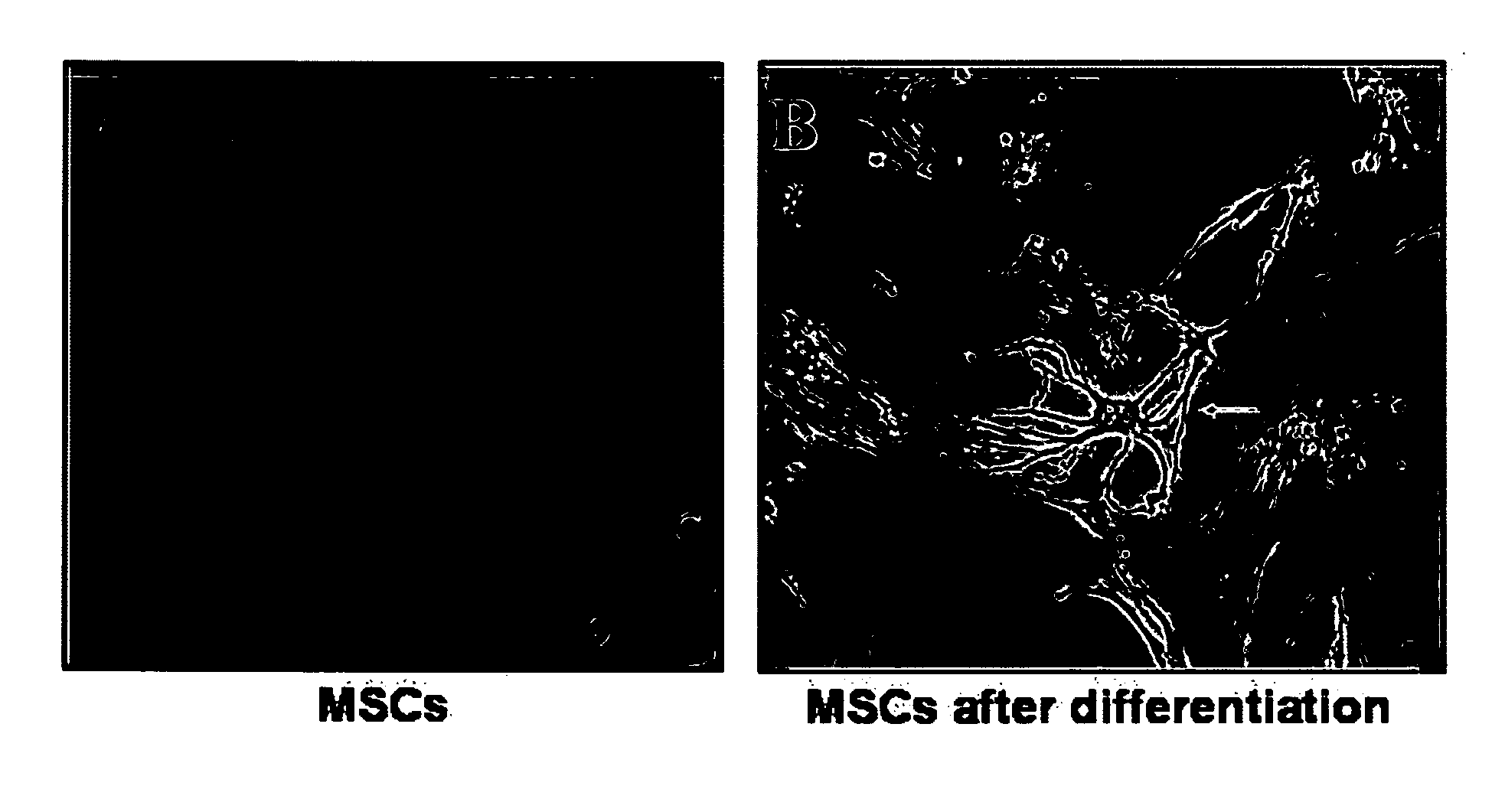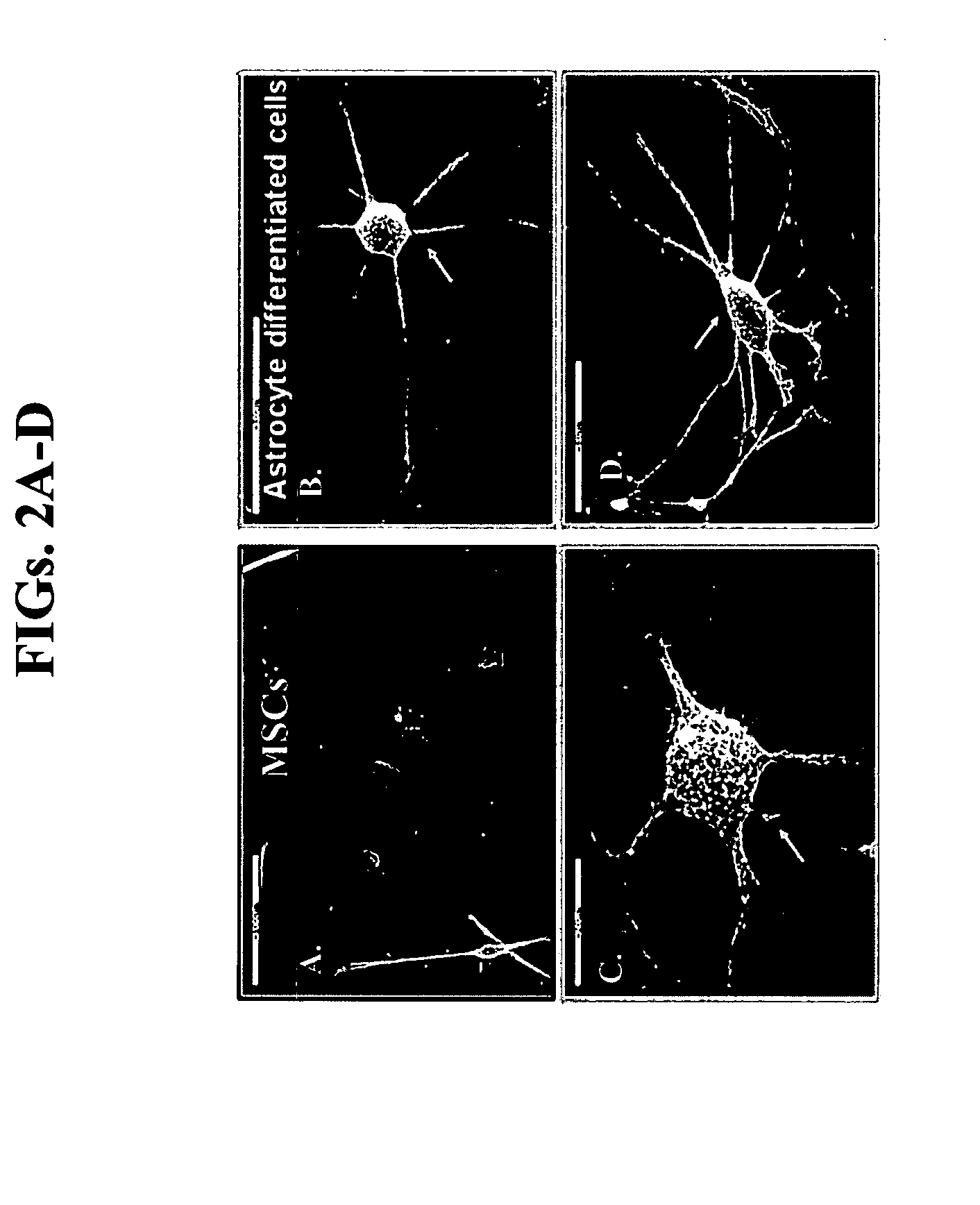Isolated cells and populations comprising same for the treatment of CNS diseases
a technology of cns disease and isolated cells, applied in the field of cells and populations thereof, can solve the problems of inability to prevent the progression of the disease, decrease in the effectiveness of the treatment, and no human mscs have been shown to be capable of secreting significant levels of neurotrophic factors
- Summary
- Abstract
- Description
- Claims
- Application Information
AI Technical Summary
Benefits of technology
Problems solved by technology
Method used
Image
Examples
example 1
Characterization of Astrocyte-Differentiated BMSCs
[0209]Materials and Methods
[0210]Isolation and culture of human BMSC: Bone marrow aspirations (10-30 ml) were collected from the posterior iliac crest of healthy adult human donors with informed consent. Low-density BM mononuclear cells (BMMNC) were separated by FICOL-PAGUE density gradient (1.077 g / ml) and washed with HBSS. Next, the cells were plated in polystyrene plastic flasks in growth medium. Growth medium consisted of dulbecco's modified eagle's medium (DMEM) supplemented with 15% fetal calf serum (FCS), 2 mM L-glutamine, 100 μg / ml streptomycin, 100 U / ml penicillin, 12.5 units / ml nystatin (SPN). The non adherent cells were removed with medium replacement. Following confluence, adherent layers were trypsinized, reseeded, grown to confluence and passaged 2 to 6 times prior to experiments. Growth medium was changed twice a week and cells were maintained at 37° C. in a humidified 5% CO2 incubator.
[0211]Astrocyte differentiation: ...
example 2
Intrastriatal Transplantation of Astrocyte-Like Differentiated hBMSc Improve the Motor Functions of Lesion Rats
[0234]In order to explore the possible therapeutic potential of the cells of the present invention, HBMSCs differentiated according to the method of the present invention were transplanted in an established rat model of Parkinson disease.
[0235]Materials and Methods
[0236]Animals: Male Sprague-Dawley rats (Harlan, Israel) weighing 220-280 g were used for the 6-OHDA-lesion experiment. All animals were housed in standard conditions; constant temperature (22±1° C.), humidity (relative, 30%), 12-h light: 12-h dark cycle and free access to food and water. Surgical procedures were performed under the supervision of the Animal Care Committee at the Rabin Medical Center and at Tel Aviv University, Tel Aviv, ISRAEL.
[0237]6-OHDA lesions: Rats were anaesthetized with chloral hydrate, 350 mg / kg i.p., and secured in a stereotaxic frame (Stoelting, USA). Animals were unilaterally injected ...
example 3
Intramuscular Transplantation of Astrocyte-Like Differentiated hBMSc Improve the Motor Functions of a Transgenic Mouse Model of ALS
[0248]Materials and Methods
[0249]Animal Model: The colony of TgN(SOD1-G93A)1Gur transgenic mice (Gurney 1994) was obtained from the Jackson Laboratory (USA). The mice were bred in CSJLF1 and at one month of age offspring was genotyped by PCR analysis, using the following PCR primers: hSOD1 upstream primer (SEQ ID NO: 19) 5′CTAGGCCACAGAATTGAAAGATCT3′; hSOD1 downstream primer (SEQ ID NO: 20) 5′GTAGGTGGAAATTCTAGCATCATCC3′; IL2 upstream primer (SEQ ID NO: 21) 5′CATCAGCCCTAATCCATCTGA3′; IL2 downstream primer (SEQ ID NO: 22) 5′CGCGACTAACAATCAAAGTGA3′. The annealing temperature was 53° C., the PCR products 236 bp (hSOD1), 324 bp (IL2). Mice to be used in this study were healthy until 3 months of age and became completely paralyzed between 4 and 5 months of age. Animal experiments were approved and supervised by the Tel-Aviv University.
[0250]Cell transplantation...
PUM
| Property | Measurement | Unit |
|---|---|---|
| concentration | aaaaa | aaaaa |
| concentration | aaaaa | aaaaa |
| concentration | aaaaa | aaaaa |
Abstract
Description
Claims
Application Information
 Login to View More
Login to View More - R&D
- Intellectual Property
- Life Sciences
- Materials
- Tech Scout
- Unparalleled Data Quality
- Higher Quality Content
- 60% Fewer Hallucinations
Browse by: Latest US Patents, China's latest patents, Technical Efficacy Thesaurus, Application Domain, Technology Topic, Popular Technical Reports.
© 2025 PatSnap. All rights reserved.Legal|Privacy policy|Modern Slavery Act Transparency Statement|Sitemap|About US| Contact US: help@patsnap.com



